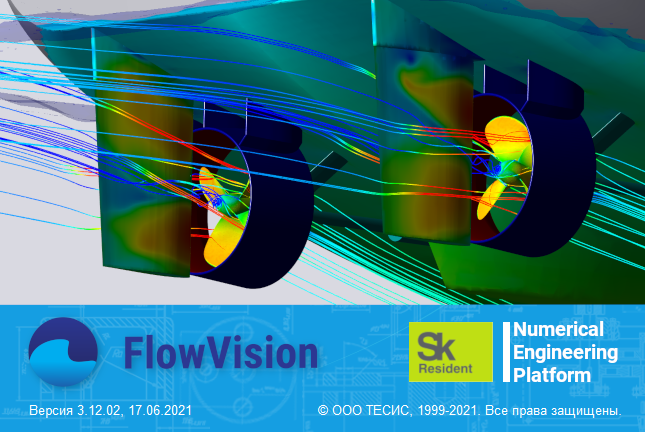17 June 2021 marks the release of FlowVision 3.12.02.
This release is focused on improvements to the quality of users' interaction with the programme. Here's a quick overview of the useful new additions to this latest version of FlowVision.
Important Changes
The library LibFvMPI has changed. If the user has created their own version of this library in order to interact with some specific MPI version in Linux, then it will be necessary to recompile it using the new source codes from the distribution kit.
development of physics models
-
Implementation of an ablation model, which simulates destruction of a porous thermal barrier coating (TBC) and removal of mass from its surface. Gases formed during pyrolysis move through the pores and leave the TBC.
- The quadratic KEQ turbulence model has been replaced by the new non-linear KENL turbulence model. KENL consists of a quadratic and a cubic part, which can be flexibly adjusted for modelling external flows that form large regions of reverse-flow. The quadratic part of the KENL model sets the sensitivity of the reverse-flow model, while the cubic part accounts for the formation of vortices.
- The "discrete ordinates method" radiation model has been extended to include new boundary conditions: "Radiation flux density" and "Point source".
- For dispersed media, it is now possible to set:
- user-defined force, that acts on the particles (in the Motion physical process settings for the Particle phase)
- user-defined mass source (in the Mass Transfer physical process settings for the Particle phase)
- a model for particle transformations – model with variable particle diameter (in the general Mass Transfer model settings for the Particle phase), to model the mass loss of the dispersed phase.
NEW PREPROCESSOR FEATURES
- Setting a 2D direction in initial grid properties makes the computational grid 2-dimensional, disabling refinement in the chosen 2D direction. This makes it more feasible to run many evaluative simulations (for example when conducting mesh convergence tests) by significantly conserving computational resources.
- A new feature of computational grid adaptation in tasks utilising the Gap model will help save computational resources. This is made possible by disabling unnecessary (excess) refinement within gaps.
-
It is now possible to solve problems with an unevenly distributed surface tension coefficient (Marangoni convection). To do this, enable the option «Surface Sigma gradient». This is relevant when modelling thermocapillary processes, or the wetting of hydrophobic surfaces.
-
To speed up the modelling of viscous flows, it is now possible to disable using pressure gradient when calculating explicit time step. The practicality of this feature can be explained by the physics of these processes: viscous flows are characterised by low velocities and, simultaneously, large pressure gradients, which decrease the time step.
NEW POSTPROCESSOR FEATURES
- The layers "Plot along line", "Plot along curve" and "Plot along ellipse" can now be displayed in the Viewer module.
-
The «Nodal loads» layer can now colour vectors based on their magnitude and display loads in the coordinate system assigned to the Moving body modifier.
- Enabling the "Extended Data" option for characterics on surfaces now calculates additional scalar and vector integral data.
- Rendering of the "Solids" layer is now performed much quicker, which speeds up results processing for tasks with multiple Subregions.
Improvements to the user interface
- It's now possible to quickly generate and command file using the teriminal and the new specialised "Create command file" window. It comes with a pre-made list of typical commands as well as the ability to save a command file as a template for future use.
-
Launching a simulation via the Terminal has become much faster and easier with the addition of a new command to the Projects window - "Launch solver, load project and run".
other useful changes
- Results data exported to VTK format has improved compatibility with Paraview and Ensight.
- In FSI simulations with mapping it is no longer necessary to manually specify mapping accuracy, as this is now determined automatically.
The full list of program capabilites can be found in the descriprion included in the distribution pack (Release notes file) and also in the user manual in the section titled "What's new in FlowVision".
try the latest version of flowvision
The distribution pack for FlowVision 3.12.02 is already available to download for users with active technical support.
We wish you success in all your calculations!
